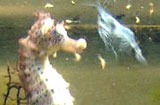 |
Seahorses are ambush predators, feeding primarily on crustaceans,
mostly shrimp. In their wild state, most seahorses only eat
live food. (Although H. capensis is an exception
and known to feed on dead food in the wild). In our aquariums,
Wild Caught specimens often don't recognize many food items
offer that are not from their natural environment. This includes
dead food, which they just don't see as food unless trained
to make the switch. |
Captive reared seahorse, on the other hand, are almost always willing
to accept frozen. It seems as though being in captivity makes them more
willing to try new foods. Even those captive reared seahorses not previously
fed frozen make the switch almost immediately in most cases.
It is ideal to offer seahorses a variety of foods - in the wild, they
would not eat only one food source, so in captivity they shouldn't be
expected to. Varying their diet allows for a more complete nutritional
profile, as well as providing mental stimulation which they often lack
by only feeding one food type.
When feeding, whether live or frozen foods, its best to offer food
that originated from a marine environment. Marine animals are rich in
Highly Unsaturated Fatty Acids (HUFAs) that freshwater organisms lack
or have in the wrong concentrations. The HUFAs are produced by phytoplankton,
base of the marine food chain so all marine organisms are dependant
on them in some way. Freshwater animals fed can be fed to marine animals,
but they need to be enriched with different products containing the
necessary fatty acids, such as Selco, or Ocean Rider Vibrance.
The exception to this rule is Brine shrimp, while they are technical
marine, coming from a saline environment, their ecosystem is much different
than the ocean, and therefore do not have the HUFA's of other marine
animals.
Live Food
Some believe that live foods are the best foods available for
seahorses. It was only a few years ago that the only foods ever
offered to seahorses was live food. The availability of captive
bred seahorses and new techniques for training seahorses has changed
that, although much live food is still offered as occasional treats
or for Wild seahorses that can't be trained on frozen food. While
there are many types available to the hobbyist, it can be difficult
to obtain from local fish stores. Culturing live food in quantities
large enough to feed seahorses provide a significant challenge
to seahorse keepers. Most cultures require large amount of space
and are labor intensive. Others breed to slow if at all. For most
hobbyists, live food has to be purchased over the internet, or
if they're lucky enough to have this option, collected from local
waters.
*IMPORTANT NOTE* Some wild caught seahorses refuse
to be trained on to frozen foods. Others learn, but stop for no apparent
reason. Anyone attempting to keep wild caught seahorses should plan
to dedicate themselves to continuously providing live food should such
circumstances arise. There are cases were no amount of diligence or
experience will result in wild seahorses eating frozen foods. For that
reason, if you are not prepared to offer live foods for the natural
life span of your seahorse, which could be up to 7 years, I strongly
suggest you do not consider keeping wild caught seahorses.
 |
Brine shrimp, Artemia
Sp.
The most common food offered
to seahorses and also probably the worst. Many fish
stores recommend feeding this because as a live food, a lot
of seahorses will react to it and eat it. However, there is
virtually no nutritional value to them, and because seahorses
have a short digestive tract, they can not even make use of
the little bit nutrients there. Seahorses fed only this will
slowly die of starvation, sometimes over a period of months.
There is some value to enriching them, although not enough
to be a staple of the diet. They are often refused as well
because they do not behave like "normal" shrimp
which are part of a seahorse's natural diet. Their swimming
habits often confuse seahorses, leaving them often to entirely
ignore the brine shrimp. |
 |
Baby Brine Shrimp, Artemia sp.
Unlike Adult Brine shrimp there is SOME nutritional value
to newly hatched baby brine shrimp. They have a nutritious
yolk reserve to allow them to hatch out and survive the first
twelve hours until they develop a complete mouth and anus.
It is when they first hatch that they are still at their most
nutritious and should be fed. Decapsulating the cyst before
hatching (removing the shells) is recommended so it takes
less energy for the brine nauplii to hatch, and are therefore
more nutritious because they've used less of their food store.
Brine shrimp can also be enriched for 24 hours before feeding.
Baby brine shrimp is the normal staple for dwarf seahorses,
and is often used to feed seahorse fry. |

Day old brine shrimp next to a penny. |
 |
Rotifers
Saltwater rotifers are microscopic organisms feed to seahorse
fry that are too small to take brine shrimp at birth, and
for supplementing the diet of adult dwarf seahorse. They are
easy to culture using phytoplankton, yeast, special rotifer
food, and even v8! There are a few different species and strains
available in aquaculture, and choosing larger ones is usually
better for seahorse fry. |

Three rotifers next to a penny for size comparison. That is
the 'T' from "IN GOD WE TRUST". |

 |
Copepods
Tiny crustaceans, most roughly the size of new born brine
shrimp. They are the best food for seahorse fry and dwarfs,
but are not easy to culture and depending on their swimming
habits, may not be noticed by some fry. There are three kinds
of copepods generally used for feeding seahorses, harpactacoid,
cyclopoid and calanoid. Harpactacoid are the easiest to culture,
but they prefer living on the surface of objects, and thus
do not always attract the attention of seahorses.They can
be gathered from aquariums at night when they are most commonly
found on the sides of the aquarium. Culturing just requires
a container with an airline set on low, and crushed flake
food. Calanoids swim in the water column which makes them
ideal for seahorse fry and dwarves. However they are not easily
cultured. Most used for seahorse food are caught directly
from the ocean. Cyclopoids (cyclops) are found in refugiums
occasionally and fed out. They are predatory, so culturing
is probably not an option. |
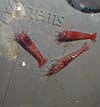 |
Red Shrimp, Opa'e ula,
Halocaridina rubra
Small brackish water shrimp endemic to Hawaii. They are an
excellent seahorse food and very few seahorses will refuse
them. They are, however, not easy to obtain and must be purchased
through mail order sources. They also have a slow reproduction
rate, producing a few young only a couple times a year, making
culturing at home impractical. |
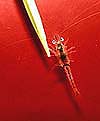
Mysis relicta photo courtesy of PE
Mysis |
Mysis shrimp, Opossum
shrimp, Mysis sp., Mysidopsis sp. and
similar
Another great seahorse food, readily accepted. Mysis "shrimp"
aren't actually shrimp, but a very shrimp like crustacean.
They probably make up a large portion of the diet of wild
seahorses. They reproduce at an alarming rate, producing
young every 1 - 2 weeks, and are sexually mature at around
15 days.The young are born alive, and new born mysis make
excellent food for juvenile seahorses that are starting
to outgrow bbs. They however require a lot of time and energy
culturing as the young need to be separated from the adults
to prevent cannibalism. They also require feedings of newly
hatched artemia nauplii or similar twice a day.
Mysis can also sometimes be found it reef tanks among live
rock and in refugiums. Sometimes you can convince your LFS
to collect them from their live rock tanks, especially if
you're in a panic and ask REALLY nicely. Most LFS's will
do it, afraid of upsetting the crazy seahorse lady again. |
 |
Ghost shrimp, Grass
shrimp, Glass Shrimp, River shrimp
These are clear shrimp commonly found along the shore lines
and in rivers and streams. They make good seahorse food for
large species such as H. erectus or H. reidi.
The freshwater variety is often available through local sources,
such as fish stores and bait shops. Culturing is time consuming,
and either requires a large outdoor container such as a kiddy
pool or separation of the young. Freshwater ghost shrimp should
be enriched. |
 |
Amphipods, Gammarus,
Scuds
Often described as "little bugs", these segmented
crustaceans are usually present in our tanks, even under aggressive
predation. Most seahorses will poke around rocks for a quick
snack when these guys come out. If they can't live in the
tank, they will often live in the filter pads. For the occasional
treat, you can easily create a in the tank refugium which
will allow them to hide and breed. Make a small box out of
plastic screen or egg crate, and fill with algae, lightly
packed filter floss, or shredded plastic. They can also be
harvested from most bodies of water, fresh and marine. They
prefer to hide under and around algae covered rocks. |
 |
Isopods
Similar to amphipods, these relatives of the common pill bug
also make good seahorse food. Just watch out for parasitic
Isopods (they will usually have very large eyes). I have found
that tanks with isopods rarely have amphipods and tanks with
amphipods rarely have isopods. I do not know if they out compete
each other or if this is just an anomaly I observed in my
tanks. |
 |
Cleaner Shrimp Larvae
Peppermint, skunk cleaners, and Fire shrimp (less so) all
produce small larval shrimp at regular intervals when at least
two are kept together. Because they are hermaphrodites, there
is no need to sex them, just put a pair in the tank. Most
adult seahorses will ignore the larval shrimp, but juvenile
and dwarf seahorses love them. They are usually born at night,
but are positively phototrophic so can be collected by setting
up a light in/near a container to trap them. Raising them
is difficult, but having enough broodstock around can leave
you with an endless supply of shrimp larvae. |
 |
Daphnia
A freshwater relative of copepods, sometimes offered to juvenile
seahorses and there are reports of some finicky adult seahorses
taking them. Usually these are narrow snouted species such
as H. comes or H. barbouri. |
 |
Livebearer Fry
Mollys, guppys, etc . . . Some seahorses will eat livebearer
fry, while others ignore them completely. They are easy to
have around though, so many keepers have them "just in
case" |
 |
Larval Food Shrimp
These are the young of food shrimp that people eat. They can
be obtained in a variety of sizes depending on their stage
of development. Because of their use for human consumption,
they're also pathogen free. Most food shrimp dealers will
not accommodate small orders that seahorse keepers would be
looking to make. Noni (George) however, has been a god send,
more than willing to help seahorses. |
Frozen Foods
Most captive bred seahorses readily accept the appropriate frozen foods.
Some wild caught seahorses can be trained as well to eat frozen. Below
are some of the frozen foods that can be fed to seahorses.
 |
Mysis Shrimp
The staple of captive bred seahorses. As most brands
are freshwater mysis, they will need to be enriched occasionally.
Brands: SFB, Hikari, PE M.Y.S.Y.S, Gamma, Lifeline, MBF,
Mike Reed, Henkel |
 |
Plankton
Usually Krill harvested at a small size. Roughly the same size as
mysis shrimp, but may have a harder shell as seahorses seem to struggle
with them a little more
Brands: Hikari, SFB, Fish King |
 |
Krill
Good for large seahorse, such as adult H. erectus, H.
reidi, and H. ingens.
Brands: SFB seems to be the only suitably sized krill commercially
available. |
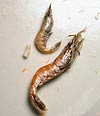 |
Ghost Shrimp, Grass Shrimp, River Shrimp, Prawns
Another freshwater animal that would need to be enriched if it was
part of the seahorses diet. Good for large species of seahorses.
Brands: Fish King (Grass Shrimp), ProSalt (Prawns), Mike Reed |
 |
Copepods
A copepod species. Sometimes accepted by seahorse fry.
Brands: Cyclop-eeze by Argent Labs, MBF |
 |
Daphnia
I have no experience with feeding frozen daphnia, but I would assume
its a good transitional food for fry if they accept it. As its a
freshwater food, it would need to be enriched.
Brands: Hikari, MBF, Mike Reed, gamma |
 |
Gammarus
I have never had the chance to offer frozen gammarus, but I suspect
they would be taken willingly. Enrich if the source is freshwater
gammarus.
Brands: Fish King, MBF, Henkel |
 |
Enriched Brine Shrimp
While its not a particularly good food source, some seahorses
are too small to eat anything other than brine shrimp. A few
companies like Hikari and San Francisco Bay put out enriched
brine shrimp. I would recommend ONLY feeding frozen brine
as a last resort, and only the enriched kind.
Brands: SFB, Hikari |
Some especially greedy seahorses are known to take pretty much any
frozen food they can eat, so don't rule out trying foods such as squid
or silversides. Be sure to cut the foods in to strips which are more
the seahorse's size.
Enriching
Enriching foods is done to complete the nutritional foods offer
to seahorses. In many cases, the foods offered, while good, lack
certain components or do not have the right proportions of the
correct components. For example, PE mysis is a great food source.
However, the HUFA EPA (Eicosapentaenoic acid ) to DHA (Dososahexaenoic
acid) ratio is too high. Too much EPA interferes with the bodies
use of other necessary fatty acids, while high DHA to EPA increases
the growth rate in fish. And many freshwater food sources do not
contain any fatty acids, which is why enriching is so important.
The number of enriching products ranges in the thousands, and are specific
to what your intended results are; such as general HUFA increase, DHA
increase, enriching for color enhancement, additional protein, etc .
. . as well as the existing profile of the food you are trying to enrich.
Discussing the specific products and uses is beyond the scope of this
article. However, some commonly use enrichment products are:
SELCO - increasing HUFAs
Spirulina - Protein, Vitamins, low in HUFAS
Naturose - astaxanthin powder for color enhancement.
Phytoplankton and Phytoplankton pastes - Increasing
HUFA, pigmentation
Vibrance - Astaxanthin and HUFAs?
SpectraVital - Rumored to be the same as Vibrance
I encourage each person to tailor their enrichment needs on the foods
that they offer. Researching enrichment products used in commercial
aquaculture is likely to give all the answers to what product is best
for you.
How to Enrich:
There are several ways one can enrich foods. I'm only covering
the ways that work best for me, but don't be surprised to find
many people suggesting many different ways.
Small Frozen Food.
Take a chunk of mysis and place in a plastic dixie cup. Add enrichment
product. Once thawed, mix up the enrichment product with the mysis and
add more if necessary. Leave overnight. The next day, rinse lightly
in a regular net. If you use a net with holes too small, the excess
of some non-liquid products don't rinse away properly. Feed to your
seahorses.
Large Frozen Foods.
WARNING, PROCEED AT YOUR OWN RISK! SHARP POINTING THINGS AHEAD!
I prefer this way of feeding because then I know the products
are getting in the food. I use it primarily for frozen ghost shrimp.
Get a small gauge need from a vet or farm supply store. Liquefy
any dry enrichment product by adding RO water and mixing in a
blender. Inject the enrichment product into the food. If its a
shrimp, I will usually insert the needle parallel to the body
as far as I can, then inject while I am removing the needle, in
hopes of producing a pocket where the enrichment goes, kind of
like a twinkie.
Bio-Encapsulation AKA Gut Loading
Here is where you feed the intended food the enrichment product
your trying to get to the seahorse. Most only take 15 minutes to
an hour to feed. For larger shrimp such as ghost shrimp, liquid
products won't work as well; feed powders and pellets. Brine shrimp
can be offered liquids and powders if the powders stay in suspension.
Adult brine shrimp only take a short while to enrich, but baby brine
shrimp require an additional 12 - 24 hours from the time they hatch
to be enriched. When enriching newly hatched brine shrimp, never
use the hatch water; always switch to freshly made water. |
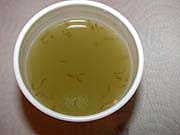
Brine Shrimp being gut loaded with selco and
algae paste. |
|
























No comments:
Post a Comment
Comments.....